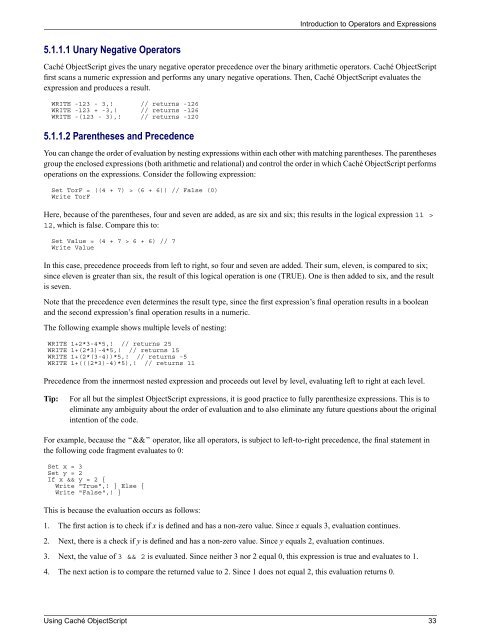Using Caché ObjectScript - InterSystems Documentation
Using Caché ObjectScript - InterSystems Documentation
Using Caché ObjectScript - InterSystems Documentation
You also want an ePaper? Increase the reach of your titles
YUMPU automatically turns print PDFs into web optimized ePapers that Google loves.
Introduction to Operators and Expressions<br />
5.1.1.1 Unary Negative Operators<br />
<strong>Caché</strong> <strong>ObjectScript</strong> gives the unary negative operator precedence over the binary arithmetic operators. <strong>Caché</strong> <strong>ObjectScript</strong><br />
first scans a numeric expression and performs any unary negative operations. Then, <strong>Caché</strong> <strong>ObjectScript</strong> evaluates the<br />
expression and produces a result.<br />
WRITE -123 - 3,! // returns -126<br />
WRITE -123 + -3,! // returns -126<br />
WRITE -(123 - 3),! // returns -120<br />
5.1.1.2 Parentheses and Precedence<br />
You can change the order of evaluation by nesting expressions within each other with matching parentheses. The parentheses<br />
group the enclosed expressions (both arithmetic and relational) and control the order in which <strong>Caché</strong> <strong>ObjectScript</strong> performs<br />
operations on the expressions. Consider the following expression:<br />
Set TorF = ((4 + 7) > (6 + 6)) // False (0)<br />
Write TorF<br />
Here, because of the parentheses, four and seven are added, as are six and six; this results in the logical expression 11 ><br />
12, which is false. Compare this to:<br />
Set Value = (4 + 7 > 6 + 6) // 7<br />
Write Value<br />
In this case, precedence proceeds from left to right, so four and seven are added. Their sum, eleven, is compared to six;<br />
since eleven is greater than six, the result of this logical operation is one (TRUE). One is then added to six, and the result<br />
is seven.<br />
Note that the precedence even determines the result type, since the first expression’s final operation results in a boolean<br />
and the second expression’s final operation results in a numeric.<br />
The following example shows multiple levels of nesting:<br />
WRITE 1+2*3-4*5,! // returns 25<br />
WRITE 1+(2*3)-4*5,! // returns 15<br />
WRITE 1+(2*(3-4))*5,! // returns -5<br />
WRITE 1+(((2*3)-4)*5),! // returns 11<br />
Precedence from the innermost nested expression and proceeds out level by level, evaluating left to right at each level.<br />
Tip:<br />
For all but the simplest <strong>ObjectScript</strong> expressions, it is good practice to fully parenthesize expressions. This is to<br />
eliminate any ambiguity about the order of evaluation and to also eliminate any future questions about the original<br />
intention of the code.<br />
For example, because the “&&” operator, like all operators, is subject to left-to-right precedence, the final statement in<br />
the following code fragment evaluates to 0:<br />
Set x = 3<br />
Set y = 2<br />
If x && y = 2 {<br />
Write "True",! } Else {<br />
Write "False",! }<br />
This is because the evaluation occurs as follows:<br />
1. The first action is to check if x is defined and has a non-zero value. Since x equals 3, evaluation continues.<br />
2. Next, there is a check if y is defined and has a non-zero value. Since y equals 2, evaluation continues.<br />
3. Next, the value of 3 && 2 is evaluated. Since neither 3 nor 2 equal 0, this expression is true and evaluates to 1.<br />
4. The next action is to compare the returned value to 2. Since 1 does not equal 2, this evaluation returns 0.<br />
<strong>Using</strong> <strong>Caché</strong> <strong>ObjectScript</strong> 33

















